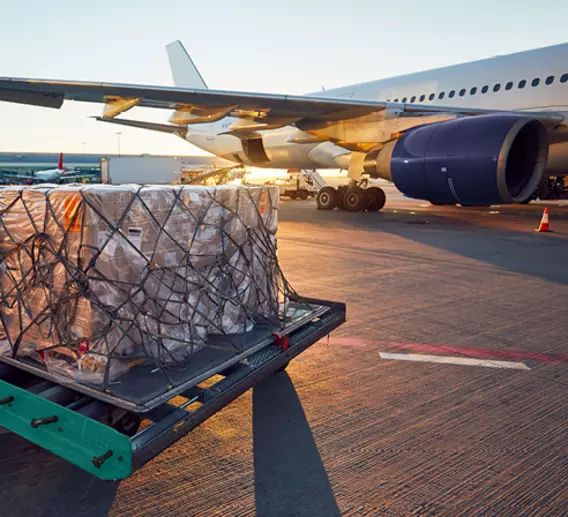Know the ins and outs of air freight
You may already be familiar with the idea of air cargo, but do you know what goes into it each step of the way? Moving shipments via air is a quick, convenient and efficient way to move goods over long distances, so knowing how the process works is crucial in preventing delays and lost freight.
Step-by-step guide to shipping air
Shipping air freight involves a process just like any other transportation solution. If followed correctly, you ensure your shipment runs smoothly — preventing delays while maintaining visibility. Here’s a breakdown of the air freight process:
1. Booking
Your first step is to book your shipment with a qualified provider. At the time of booking, be sure to have all necessary documentation, including invoices, packing lists, AWB (air waybill) and all permits that may be needed.
2. Cargo handling at origin
Before getting loaded onto the plane, your freight must be packed onto skids. It is the shipper’s responsibility to ensure freight is packaged correctly for air transport. Then, your freight goes to a cargo terminal, where it will be inspected. Finally, it will be labeled and documented. Air freight is known to be highly traceable, and these labels and documentation help with this trackability.
3. Customs clearance and inspections
Once ready for loading, international cargo will have to go through customs clearance. This will vary depending on its country of origin and destination, but your provider can walk you through inspections and ensure the load meets all legal requirements before takeoff.
Learn about shipping international air with ArcBest
4. Transport to the airport of origin
After all required inspections, the freight is transported to the airport for loading. Your provider can assist in finding transportation for this part of the process. Local cartage pick-up agents, who are TSA-certified, are used for this part of the process.
5. Loading onto aircraft
Because air cargo is specialized, airports have dedicated equipment and handlers to load your shipment onto their plane.
6. Cargo moving
Your load is now off the ground and flying towards its destination airport. Because air freight has fewer touchpoints than other modes of transportation, it will remain secure and traceable in transit. Security is the airline’s responsibility while in the air.
7. Unloading at destination airport
Once back on the ground at the destination airport, your shipment will be unloaded and transported to the destination airport’s cargo terminal for further inspection.
8. Final delivery
After a second round of inspections, this time in the destination city, the load is ready for final delivery. Your provider can help you find a carrier to make the final delivery.
Air transit options
Much like shipping any time-sensitive freight, air transit can include different shipment speeds, which vary in cost. These options include:
- Next flight out (fastest option)
- Second day (balances speed with cost)
- Deferred (the most cost-efficient air solution where your freight will be on standby)
- Charter (provides a dedicated aircraft for your cargo)
Find more on air transit options here
Elevate your supply chain
Utilizing air freight shipping can help bring your supply chain to new heights. Call ArcBest today and discuss your air transit options. With flexible air freight options and a team of professionals with vetted air carrier partners, ArcBest is here to provide a full suite of air shipping solutions.

